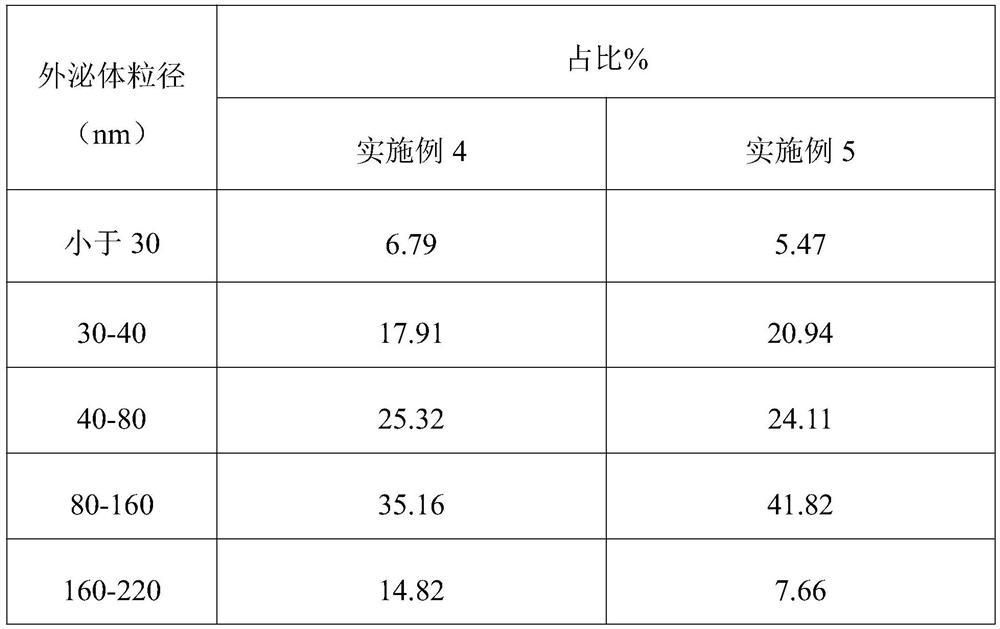Separation method and application of hair follicle stem cell exosome
A hair follicle stem cell and separation method technology, applied in cell dissociation methods, animal cells, vertebrate cells, etc., can solve the problems of poor separation effect and low purity of exosomes, and achieve improved purity and concentration, improved separation effect, The effect of avoiding clogging
- Summary
- Abstract
- Description
- Claims
- Application Information
AI Technical Summary
Problems solved by technology
Method used
Image
Examples
Embodiment 1
[0057] The purpose of this embodiment is to provide a kind of preparation mode of the product to be separated:
[0058] (1) Thawing and resuscitation of hair follicle stem cells:
[0059] 1) Take out the P3 generation hair follicle stem cells (the P4 generation after thawing) from the liquid nitrogen, quickly put it into a 37C water bath, clamp it with tweezers and shake it vigorously until there is no obvious ice cubes to take out;
[0060] 2) Gently wipe the nozzle with an alcohol cotton ball, and then move it into the ultra-clean workbench.
[0061] 3) Remove the cell fluid with a pipette and transfer it to a new centrifuge tube, and centrifuge at 1500 r / min for 5 min.
[0062] 4) Discard the supernatant and resuspend in stem cell culture medium (containing DMEM / F12, 10% FBS, 1% PS, 20ng / mL EGF, 10μL / mL ITS).
[0063] 5) Add stem cell culture medium to a 100mm petri dish, inoculate the cell suspension, and place it at 37°C, 5% CO 2 Culture in a humidified incubator.
[...
Embodiment 2
[0072] The purpose of this embodiment is to prepare a kind of porous microsphere, and the concrete steps are as follows:
[0073] Mix the dissolved polylactic acid (the mass of polylactic acid is 2.0 g) with 100 mL of 2w / v% polyvinyl alcohol (and add 0.05 g of ammonium persulfate), and stir for 30 h at 80°C and 55 rpm to obtain a mixed solution. Liquid 1; then quickly mix mixed liquid 1 with sodium alginate, and stir for 6 hours at 250 rpm to obtain mixed liquid 2; suck mixed liquid 2 into a syringe, and then drop in 5w / v% calcium chloride In the solution, microspheres are prepared; after removing the residual calcium ions on the surface of the microspheres with distilled water, the microspheres are soaked in a sodium hydroxide solution for 25 minutes to prepare porous microspheres.
Embodiment 3
[0075] The purpose of this embodiment is to prepare a kind of porous microsphere, and the concrete steps are as follows:
[0076] Mix the dissolved polylactic acid (the mass of polylactic acid is 2.0 g) with 100 mL of 2w / v% polyvinyl alcohol (and add 0.05 g of ammonium persulfate), and stir for 30 h at 80°C and 55 rpm to obtain a mixed solution. Liquid 1; then quickly mix mixed liquid 1 with sodium alginate, and stir for 6 hours at 250 rpm to obtain mixed liquid 2; suck mixed liquid 2 into a syringe, and then drop in 5w / v% calcium chloride In the solution, the microspheres were prepared; after removing the residual calcium ions on the surface of the microspheres with distilled water, they were mixed with polyacrylamide, and after stirring for 12 hours, they were immersed in glutaraldehyde solution (0.1w / v%), and 50 Under the condition of ℃, the water bath was stirred, and the stirring time was 50 min. The microspheres were then soaked in sodium hydroxide solution for 25 min t...
PUM
| Property | Measurement | Unit |
|---|---|---|
| particle diameter | aaaaa | aaaaa |
Abstract
Description
Claims
Application Information
 Login to View More
Login to View More - R&D
- Intellectual Property
- Life Sciences
- Materials
- Tech Scout
- Unparalleled Data Quality
- Higher Quality Content
- 60% Fewer Hallucinations
Browse by: Latest US Patents, China's latest patents, Technical Efficacy Thesaurus, Application Domain, Technology Topic, Popular Technical Reports.
© 2025 PatSnap. All rights reserved.Legal|Privacy policy|Modern Slavery Act Transparency Statement|Sitemap|About US| Contact US: help@patsnap.com

